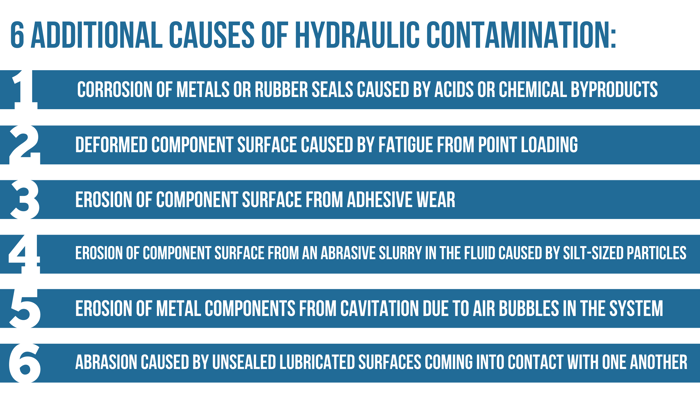Particles in the Fluid Can Cause Hydraulic System Failure
Hydraulic system components can fail due to a microscopic particle in the fluid (a dust speck, a small metal chip, abrasive dirt, moisture, etc.) This can cause a ripple effect in the system and damage system components. Often, the cause of the problem is a faulty or incorrect seal, allowing particles to enter and contaminate hydraulic fluid. This, along with improper handling of components, can all create costly system failure and force expensive downtime.
Corrosion Is Another Major Cause of System Problems
When corrosive particles enter the fluid system, it can lead to rust and pitting of hydraulic parts, the decline of a component’s performance and eventually hydraulic system failures.
Incorrect or defective seals can often lead to system failures in hydraulic cylinders or piston rods. Seals can fail due to frequent actuation of piston rods and cylinders under considerable force. This can lead to exposure of components to the elements, causing corrosion and/or contamination of system fluids, allowing particles of rust to flake off into the fluid.
Hydraulic System Contamination
Incorrect seal selection, poorly filtered oil, contamination during manufacturing, water intrusion, and wear on hydraulic components may all lead to system failure.
Extrusion and Nibbling of O-rings
When the edges of the O-ring on the low-pressure side of the hydraulic rod or piston seal fail, they can appear nipped, chipped, or 'frilly'. In extreme cases, O-rings can be shaved where the surface of the O-ring begins to peel off. The high pressures and pulses that cause the material to stick to the mating edges of the components can lead to the O-ring's extrusion. This can cause O-rings to get trapped between the mating surfaces' sharp edges, damaging the seal, which is referred to as nibbling.
A stronger seal material or backup seals that reduce clearance gaps can often solve the problem, reducing the possibility of nibbling and extrusion. The seals best suited for your application can minimize or even eliminate particles entering and contaminating the system.
6 Additional Causes of Hydraulic Contamination

Solutions in Reducing Hydraulic Contamination
Hydraulic system contamination can be a constant problem, but there are ways to reduce its impact. Proper handling and storage of fluids can make a huge difference. You can also reduce contamination by ensuring you use the correct seals and O-rings; confirm they are installed properly and plan scheduled maintenance to preserve their integrity.
Hydraulic Fluid Selection, Handling and Storage
Seals and O-rings are not the only thing that matter. It all starts with choosing the right fluid for the application. The system can be damaged from using the wrong additives or mixing different fluids. Hydraulic fluid systems are also susceptible to water contamination. Even simple moisture can cause system fluid degradation and component corrosion.
Hydraulic fluids must be kept in sealed containers until they are ready for use. Drums and other containers must be kept dry, sealed tightly and protected against moisture from rain and humidity. These steps will help to prevent water ingress into the container.
Additional Steps to Control Hydraulic Contamination
- Follow procedures for system maintenance to monitor or change fluids if necessary. Before changing hydraulic fluid, it is important the system is flushed and cleaned prior to the addition of the new or replacement fluid.
- Protective plugs and caps for fittings, hose assemblies, and valves are used when components are not in use or when a port becomes redundant. Protecting hydraulic components against corrosion, dirt and moisture is crucial during manufacturing, storage, and shipping. Open ports in components, hose assemblies or fittings are like an open window to dirt, moisture and other particles.
- Use scrubbers to clean parts and hydraulic filters to remove contaminants from the fluid.
Conclusion
Particulates of abrasives such as dirt, metal flakes, slivers or the ingress of moisture are primary causes of hydraulic system contamination. They can lead to severe damage and reduced efficiency. The ability to control pressure and flow can also be affected by contaminants.
The simplest solutions to controlling hydraulic system contamination are the use of proper seals and O-rings, keeping the fluid clean, using caps to seal off hose assemblies, fittings and component ports (such as valves) when in storage or transport.
Sources Include:

